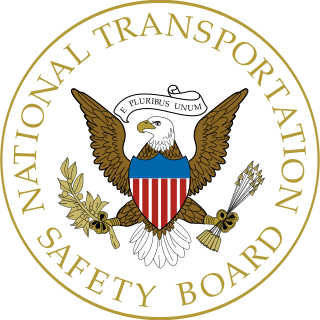
The National Transportation Safety Board (NTSB) is an independent U.S. government investigative agency responsible for civil transportation accident investigation. In this role, the NTSB investigates and reports on aviation accidents and incidents, certain types of highway crashes, ship and marine accidents, pipeline incidents, bridge failures, and railroad accidents. The NTSB is also in charge of investigating cases of hazardous materials releases that occur during transportation. The agency is based in Washington, D.C. It has four regional offices, located in Anchorage, Alaska; Denver, Colorado; Ashburn, Virginia; and Seattle, Washington. The agency also operated a national training center at its Ashburn facility.

An aviation accident is an event during aircraft operation that causes serious injury, death, or destruction. An aviation incident is any operating event that compromises safety but does not progress to an actual accident. Preventing accidents and incidents is the main goal of aviation safety.

The Air Accidents Investigation Branch (AAIB) investigates civil aircraft accidents and serious incidents within the United Kingdom, its overseas territories and crown dependencies. It is also the Space Accident Investigation Authority (SAIA) for the United Kingdom. The AAIB is a branch of the Department for Transport and is based in the grounds of Farnborough Airport, Hampshire.

United Airlines Flight 859 was a Douglas DC-8, registration N8040U, on a scheduled passenger flight that crashed on landing at Stapleton International Airport in Denver, Colorado after departing from Omaha, Nebraska's Eppley Airfield on July 11, 1961. Eighteen people were killed, and 84 were injured.

The Transport Safety Investigation Bureau (TSIB) is a department within the Ministry of Transport of the Government of Singapore and is an independent investigation authority, responsible for the investigation of air, marine and land transport accidents and incidents in Singapore. The head office is in Passenger Terminal 2, Changi Airport, Changi, Singapore. It was formed on 1 August 2016 as a restructuring of the Air Accident Investigation Bureau (AAIB) of Singapore.

In aviation, a mid-air collision is an accident in which two or more aircraft come into unplanned contact during flight. Owing to the relatively high velocities involved and the likelihood of subsequent impact with the ground or sea, very severe damage or the total destruction of at least one of the aircraft usually results.

The following are lists of disasters.

The Flight Safety Foundation (FSF) is a non-profit, international organization concerning research, education, advocacy, and communications in the field of aviation safety. FSF brings together aviation professionals to help solve safety problems and bring an international perspective to aviation safety-related issues for the public.
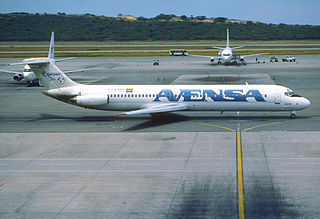
Avensa Flight 358 was a scheduled airline flight from Maturín Airport to Simón Bolívar International Airport in Venezuela that crashed on 22 December 1974 killing all 75 people on board.

Aerolíneas Argentinas Flight 644 was a scheduled flight operated by the Douglas DC-6, registration LV-ADW, on 19 July 1961 which was due to operate a domestic scheduled passenger service between Ministro Pistarini International Airport in Buenos Aires City and General Enrique Mosconi International Airport in Comodoro Rivadavia, but crashed 12 km (7.5 mi) west of Pardo, Buenos Aires Province, Argentina, half an hour after takeoff, owing to severe turbulence during climb out. This aircraft had been originally named 'Presidente Peron' but by 1956-57 had been renamed 'General San Martin'. Some reports stated the aircraft was struck by lightning.

On 10 November 1971, a Merpati Nusantara Airlines Vickers Viscount, registration PK-MVS, crashed in the Indian Ocean off the coast of Padang, West Sumatra, Indonesia, after telling air traffic controllers they could not make their destination due to bad weather. All 69 people aboard the aircraft were killed in the crash. It remains the third worst Vickers Viscount accident.
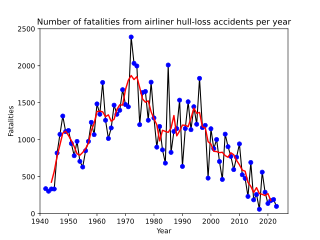
A hull loss is an aviation accident that damages the aircraft beyond economical repair, resulting in a total loss. The term also applies to situations where the aircraft is missing, the search for their wreckage is terminated, or the wreckage is logistically inaccessible. The aviation industry uses the metric of "Hull losses per 100,000 flight departures" to measure the relative risk of a given flight or aircraft. There is no official ICAO or NTSB definition.
The following lists relate to aviation:
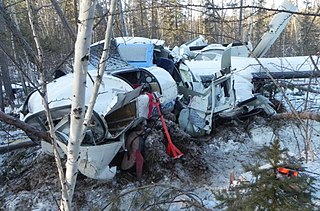
Khabarovsk Airlines Flight 463 was a scheduled domestic passenger flight from Nikolayevsk-on-Amur Airport to Nelkan Airport in Russia. On 15 November 2017 the Let L-410 Turbolet operating the flight crashed short of the runway at Nelkan Airport, killing all but one of the seven people on board. The sole survivor was a three-year-old girl who sustained serious injuries. The crash was caused by a malfunction of the right engine's propeller.
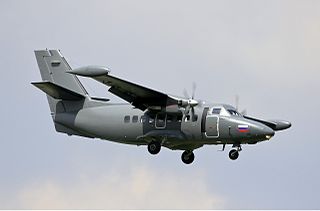
Sakha Avia Flight 301 was a scheduled domestic passenger flight from Kutana to Aldan via Uchur in Russia. On 26 August 1993 the Let L-410 Turbolet operating the flight crashed on approach to Aldan Airport, killing all 24 people on board. It is the deadliest aviation disaster involving the Let L-410 Turbolet.
This page is based on this
Wikipedia article Text is available under the
CC BY-SA 4.0 license; additional terms may apply.
Images, videos and audio are available under their respective licenses.













